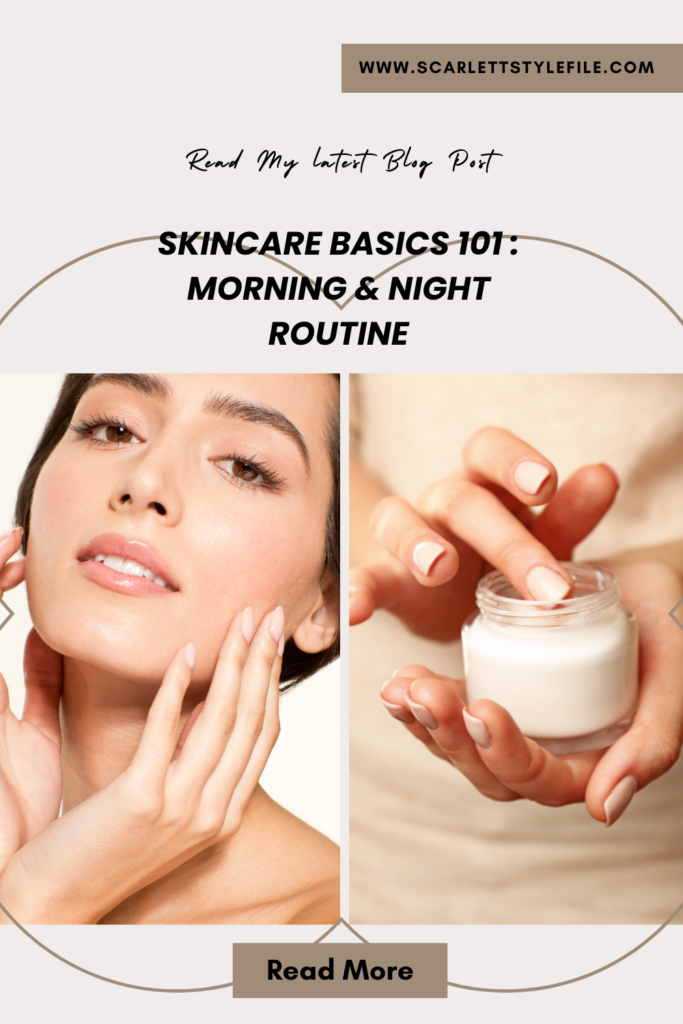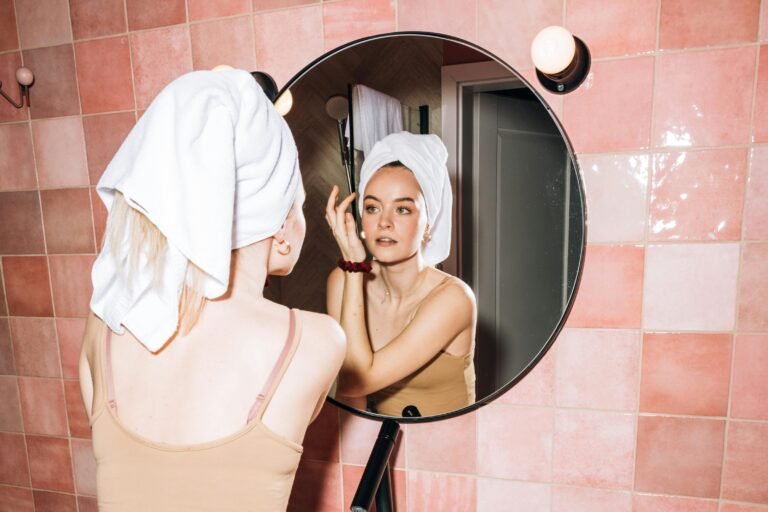Skincare Basics 101 : Morning & Night Routine
This post may contain affiliate links. That means that if you click on a link and purchase something I recommend, I will receive a small commission at no extra cost to you. As an Amazon Associate, I earn from qualifying purchases. This helps keep my website up and running and is very appreciated. Thank you for your support! Disclaimer
In today’s article, I wanted to make things simple, just stick to the skincare basics 101 for those who like to keep it minimal. There are so many skincare brands out there, it’s overwhelming. New ones pop up all the time, each claiming to work miracles. It’s confusing for me, so I can only imagine how overwhelming it must be for someone new to skincare. That’s why I decided to break it down for them. So let’s get started
If you don’t have time to read this post right now, why not save it for later?

Skincare Basics 101 : Morning & Night Routine
tips for nighttime routine
cleansing:

Let’s talk about your nighttime skincare routine. Why nighttime, you ask? Well, it’s all about giving your skin a fresh start. Forget the notion that your skin snoozes while you doze; it’s busy all day long. The real deal is this: the nighttime ritual is your chance to rid your skin of the day’s grime. And let’s emphasize the cornerstone of this routine: cleansing. This step can either make or break your skin’s condition.
Never, ever hit the hay with makeup on—layering makeup over sunscreen, coupled with a day’s worth of pollution, is a recipe for disaster. It’s a surefire way to invite those pesky reactive oxygen species (ROS) to the party, accelerating the aging process. So, washing your face? It’s the best investment you can make for yourself, and it doesn’t break the bank. Dry skin, oily skin, acne-prone, sensitive, you name it—everyone should cleanse at night.
Why? Because every human operates during the day, and your face bears the brunt of that exposure. So, regardless of your skin type or the environment you’re in, make washing your face at night your non-negotiable first step.
targeting skin concerns:

Once you’ve completed your nightly face wash routine, it’s time to target those skin concerns. What do I mean by that? Well, step two is all about addressing the specific problems your skin is facing. Unlike life’s myriad complexities, your skin typically deals with a more manageable range of issues—usually one to five at a time.
Think along the lines of fine lines, redness, pigmentation, and breakouts. Now, not all breakouts are created equal; they can vary from minor nuisances to major disruptions like elasticity concerns. So, let’s narrow it down to the four primary issues: fine lines, redness, pigmentation, and breakouts.
Of course, there’s a miscellaneous category—think allergic reactions, eczema, psoriasis, and other medical conditions, which ideally warrant a dermatologist’s attention and prescription medication.
Let’s stick with the core four for simplicity’s sake, shall we? I’m just here to simplify the process, folks. Sure, there might be other concerns lurking, but let’s keep it straightforward for now.
Alright, onto step two: once your face is all cleansed, it’s time to bring in the targeted serum for your specific issue. Resist the urge to splurge on a multitude of serums to tackle every single problem simultaneously. Doing so will likely overwhelm your skin, your mind, and your wallet.
Take it one step at a time. Why? Because it allows you to commit to the routine of using that particular product consistently. This gives your skin the opportunity to truly gauge its response and observe any noticeable changes.
Remember, addressing skin concerns requires patience—typically around six to eight weeks to start seeing results. Since your skin operates on a 28-day cycle, doubling that timeframe is necessary to witness a significant difference.
So, perseverance is key. When unsure, stick with it. Always. Additionally, streamline your approach by focusing on specific issues. If acne is your nemesis, concentrate on an acne-fighting regimen. Dealing with hyperpigmentation? Prioritize treatments that target evening out your skin tone and tackling fine lines. Building collagen is essential; this is where serums, treatments, or prescribed medications enter the picture. so, that wraps up step two.
eye care:

Next up are the eyes. Do you need a super specific eye cream? Honestly, no, you really don’t. I mean, you genuinely do not. Unless you’re dealing with periorbital dermatitis, which can mimic acne but isn’t quite the same, your eye area probably isn’t prone to breakouts.
What you might want to consider is using a very gentle retinol, the mildest one you can find over the counter, lightly under your eyes. Then, you can either follow it up with Vaseline or, if you’re particularly sensitive, apply Vaseline first and then layer the retinol on top. This way, the Vaseline acts as a buffer, reducing the risk of irritation around your eyes.
Moisturizing:

Right before you go to bed, it’s important to give your face some moisture. You want it to look all shiny and healthy, like a glazed doughnut. So, you put on moisturizer before sleeping to lock in all the good stuff. This helps your skin get the water and nutrients it needs. Hydration isn’t just about using hyaluronic acid though. I can’t stand the stuff (I’m that bitch biggest hater)
You need to give your skin things like humectants so it can take care of itself. That’s where moisturizers come in. But not all moisturizers are the same. It depends on where you live and how humid it is. In dry places, you need a thick moisturizer. In humid areas, you can use a lighter one or even skip moisturizing altogether. And that’s how we move into our daytime skincare routine.
tips for morning routine

cleansing:
If your skin tends to be on the drier side rather than an oil slick, you might want to rethink your morning routine. You can actually skip the whole cleansing shebang and just splash your face with water. And no, I’m not talking about a light misting here. I mean a good, solid splash to clear away any leftover nighttime products.
Now, if your skin errs on the side of oily, a morning cleanse might be in order. But here’s the kicker: too much cleansing can backfire and kickstart even more oil production. So, it’s all about finding your balance. Maybe try skipping the morning cleanse four days a week and only doing it at night, or mix it up depending on how your skin feels. There’s no one-size-fits-all approach here. Get to know your skin, see what works, and roll with it.
using vitamin C:
Once you’ve washed your face with water, the next big thing for your daytime routine is using vitamin C serum. It’s super common and easy to find in places like drugstores, beauty shops, and even regular stores like Target or Walmart. Vitamin C is a powerful antioxidant that helps your sunscreen do its job better. So, after washing your face, slap on some vitamin C serum as step two in your skincare routine. Easy peasy!
Related : Unveiling The Power Of Vitamin C: Your Ultimate Guide To Glowing Skin
moisturizing:
So, step three can be a bit tricky. Let me explain why. I was in Seoul last month, and let me tell you, most people there are still wearing masks all day long, even though it’s not particularly humid. So, if you’re someone who wears a mask for more than eight hours a day—okay, that’s just a guess, it could be five hours too—or if you live in a really humid place, or both, you might want to skip the moisturizer.
Instead, go for a super light hydrating serum, like the Aveeno one. I really like the Aveeno Calm and Restore or the Avéne Hydrants Intense. Just apply sunscreen afterward, no need to layer moisturizer under it. But if you’re in a dry area and you don’t wear a mask all day, and your skin feels super dry, start with a thick, creamy moisturizer, then put on sunscreen. And that’s pretty much your morning routine sorted.

And this is a skincare guide for dummies. It’s actually pretty straightforward once you think about why you’re doing each step. The most important thing, which I find surprising how often people forget, is to pay attention to your skin.
Watch how it reacts to different things. How do you do that? Well, give it time to adjust to a new product. You won’t see a change overnight or even in a week. It usually takes six to eight weeks to really notice any differences.
And that’s it! That’s the basics of a skincare routine, almost too easy. But you know what? There’s real beauty in keeping it simple, trust me.
The Bottom Line
I hope you all liked reading this article. I just wanted to make it simpler and easier to understand for everyone. I hope it shows you that skincare doesn’t have to be complicated. When you strip away all the extra stuff, you’ll see how much it can improve your skin.
Feel free to leave any questions or feedback in the comments. I truly value my readers’ input.


